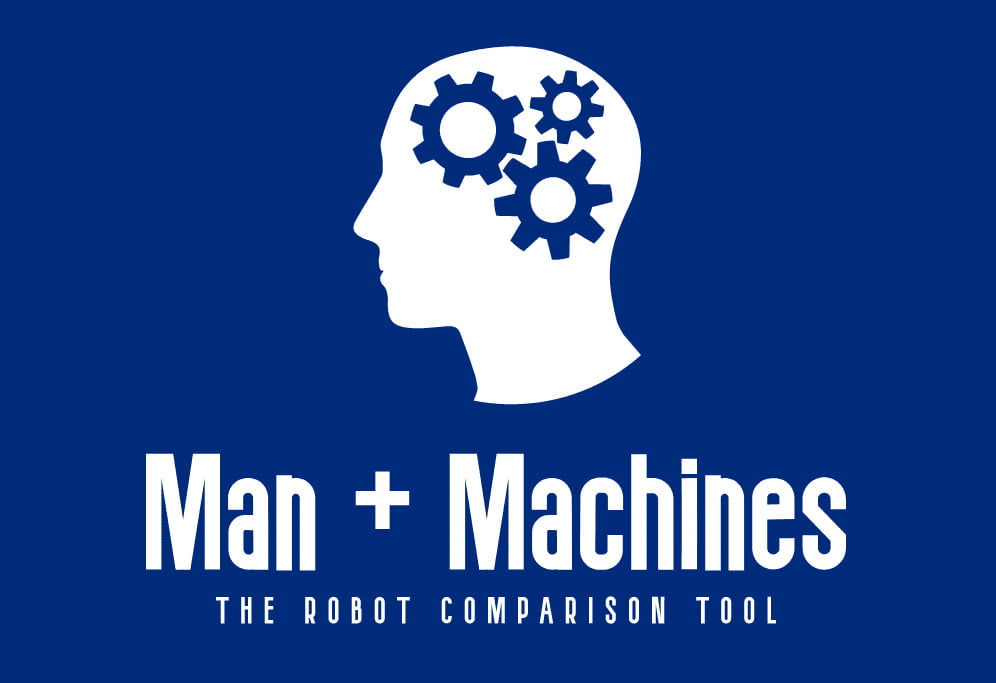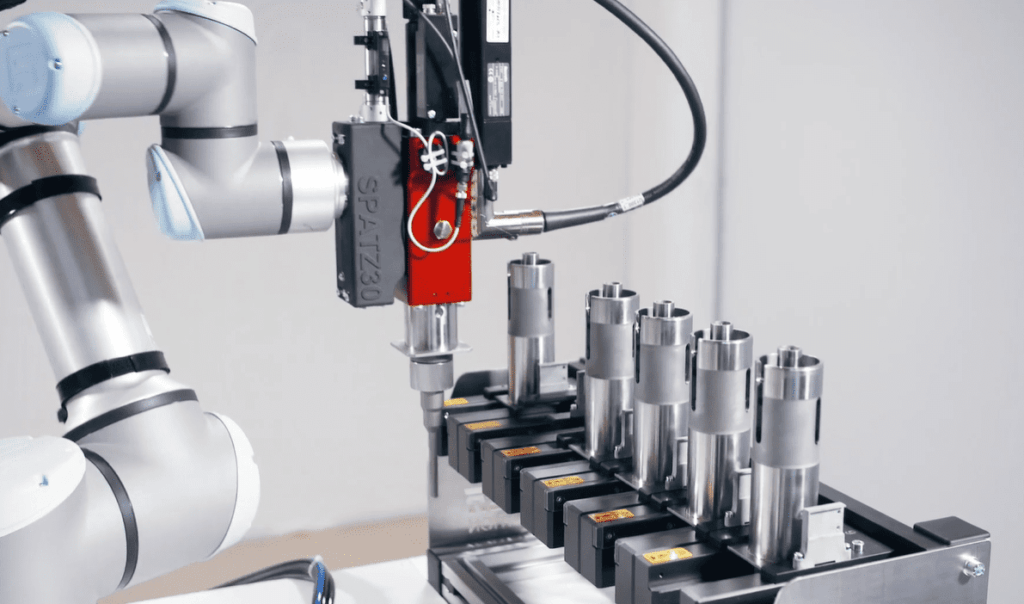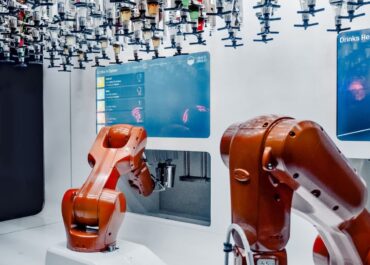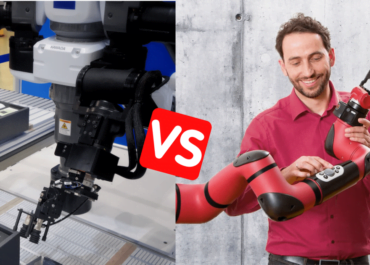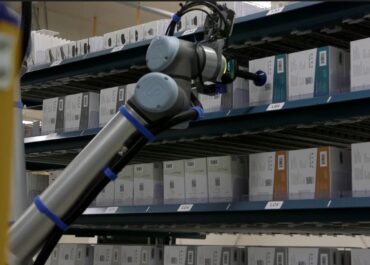Driving screws all day is a demanding and dull job for workers.
Operators need to accurately position the screws, manually fasten them, and repeat on many different settings. Plus, they put themselves at risk of repetitive strain injury (RSI).
So is it worth assigning them to these tasks, when more consistent and accurate screwdriver solutions exist?
Collaborative robots are one of those alternatives, as they can precisely drive screws on any surface thanks to torque and force sensors.
As it’s not easy to get started, here’s a guide on how to automate your screwdriving application with a robot.
Why use robots to automate your screwdriving applications?
We know the feeling.
You’ve placed some of your staff on screwdriving assembly processes, and you’ve realized their output is inconsistent.
One day, the screws are well fastened; the other day, some of them are too loose. Besides that, some of your employees are unwilling to work on screwdriving lines, complaining about tedious and repetitive gestures.
So you’re wondering: what are other ways to handle your screwdriving tasks?
A good option is articulated robots, as their dexterous arms can drive screws uniformly. Collaborative robots (cobots) especially demonstrate high accuracy and adaptability when it comes to screwdriving.
Contrary to industrial robots, they are quite affordable, safe and any worker can learn to deploy and program them.
Implementing a screwdriving collaborative solution will help you get :
- Consistent and reliable output: thanks to accurate force and torque sensors, cobots can execute the same gesture and apply the right force every time, while working around the clock. That’s good for output quality and throughput.
- Flexible screwdriving processes: cobots are easy to set up and reprogram on new screwdriving settings to enable fast changeovers. They can also detect screw defects and reach distant parts from every angle.
- Better working conditions for workers: as your operators don’t need to perform repetitive motions anymore, they can handle more rewarding tasks. They are also safe from injury, as cobots prevent any collision.
Does this spark your interest? Let’s take a closer look.
Screwdriving robots : our top 3
Many cobots models can support screwdriving applications. But depending on their technical specs and tool compatibility, some better handles this task than others. Here’s our top choice:
UR

Universal robot is undoubtedly the most popular cobot brand on the market. Besides having an extensive spec range, its UR cobot models show great versatility, ease of use, and safety to automate your screwdriving application. They also connect with a wide ecosystem of screwdrivers and screw feeders, so to make sure you get the tools that fit your industrial requirements.
Techman

Techman cobots are known for one thing: vision. Their built-in vision scanner can help you handle more flexible screwdriving processes. While accurately positioning and fastening screws, they can also count them and inspect their quality. Of course, those tasks can require some complex programming, but they give you more intelligence over your production processes.
Dobot

A newcomer to the industrial market, Dobot provides a full-package robotic screwdriver solution. With innovative locking, vibration suppression, and full-parameter calibration technology, it can achieve a high-speed, stable operation and precise positioning in complex production settings.
The solution seamlessly connects with the Dobot user-friendly programming interface, which enables you to calibrate and teach the right positioning.
Robotic screwdriver: our featured list
In recent years, robot manufacturers have designed innovative screwdriving tools for robots. Here are the best ones out there that you can attach to your robot arm :
Robotiq

Robotiq all-in-one screwdriving solution is an unavoidable option to consider on the market. The screwdriver kit is quick and easy to connect to your cobot and to reconfigure on new settings. The URcap software enable you to program your application in minutes, by automating the communication between the screwdriver, screw feeder, robot, and vacuum technology. It also helps you leverage force-sensing capabilities like screw detection and teaching by demonstration for highly efficient applications.
OnRobot

OnRobot screwdriver focuses everything on flexibilty. The robot screwdriver and screwfeeders are easy to reconfigure on other screw type and length, and set up on any cobot arm for fast changeovers. The OnRobot intelligent Screwdriver software speeds setup and programming, with everything you need right out of the box. Precise torque control, embedded axis and error detection ensures consistent, accurate screw insertion.
Weber

As an expert in fastener automation systems, Weber has also designed a collaborative screwdriving system. The automatic and safe HRC Screwdriving System enables workers to handle screwdriving processes with a short cycle time. They can easily set them up and apply them to new configurations.
Stoeger

Stoeger provides a modular robotic screwdriving solution. With automatic tool change, SPATZ system can automatically switch between several screwdriving tools. Besides being cost-effective and space-saving, the solution saves a lot of time since manual machine conversions are no longer necessary. Workers just need to program the cobot to pick new tools for changeovers.
How to implement your screwdriving collaborative application?
Adding a new screwdriving system into your manufacturing line requires a well though-out plan. Here’s how you can do it step-by-step:
#1 Figure out your needs
It all starts by figuring out your needs and what you want to improve in your manufacturing line. Are you looking to :
- Improve screwdriving consistency and output quality ?
- Increase throughput in your screwdriving processes ?
- Enable flexible screwdriving processes for small batches and frequent changeovers ?
- Improve your employees’ working conditions and freeing them up for more high-value tasks ?
When you know the main goals of your automation project, the choosing gets easier.
#2 Choose the right screwdriving robotic solution
To find the right automation solutions, you need to take many elements into considerations :
- Technical specifications: has your robot enough torque accuracy, reach, and speed to fit your screwdriving requirements? Does the screwdriver handle your screw types and length?
- Flexibility: is it easy to switch from one setting to another? Does your screwdriving system automate positioning, error detection, and torque sensing?
- User experience: is your screwdriving solution easy to program, deploy and set up on new configurations? Does it need technical skills or not?
- Safety: what are the safety features of your robotic screwdriving system? Does it prevent collision with the robot arm, but also screws?
#3 Think Safety First
Even though cobots are technically safe, you still need to do a safety assessment of your screwdriving process. It’s your responsibility to make sure your screwdriving system is in good use and that it doesn’t pose any threat to your workers.
The danger of screwdriving applications mainly comes from collisions with screws and arm tooling. So you need to consider every interaction between your workers, robot arms, screw, and screwing tools.
#4 Reconfigure your screwdriver work organization
Getting a robotic screwdriving system is not one more addition to your manufacturing line. You need to completely redefine your workspace and labor organization. For example, you can ease cooperation between your screwdriving robots and workers thanks to a customized working cell. You can also facilitate workers’ and robot movements in and out. That way, your workers can easily come to check your robot’s work and get back to other priorities.
Furthermore, as your robot will drive screws, who will supervise it, and what will screwdriver workers do? Will they monitor its work, manage changeovers, or handle other tasks?
We recommend leveraging human-machine collaboration – where robots continuously operate and workers monitor their work and are ready to intervene in any unexpected situation so that you get the best of both.
#5 Train your employee on the new work processes
Another priority is to make sure your employees know how to use this new automation solution. Even though collaborative robots are often easy-to-use devices, they still need to know how it works and how they can handle them. The training should particularly emphasize coding features and safety protocols. This will make sure employees are confident in their new robotic job.
Have all your questions about screwdriving robots been met ? It’s time for you to set up your screwdriving robotic solution !
